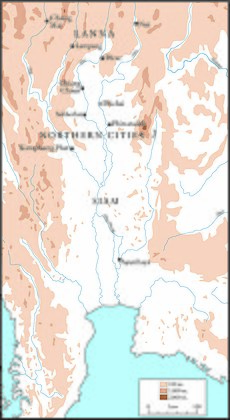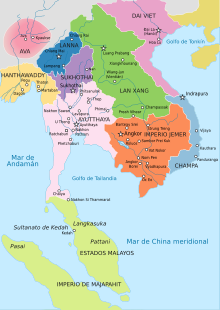Ayutthaya–Lan Na War (1441–1474)
| Ayutthaya – Lan Na War | |||||||
|---|---|---|---|---|---|---|---|
 Places listed in the Thai epic Yuan Phai, chronicling the conflict during c. 1474/75 | |||||||
| |||||||
| Belligerents | |||||||
|
Kingdom of Ayutthaya[1] | |||||||
| Commanders and leaders | |||||||
|
| |||||||
The Ayutthaya–Lan Na War (1441-1474) was a
(in northern Thailand) that started with the Ayutthayan invasion of southern Lan Na and continued with periodic breaks until 1474. Though the conflict resulted in a stalemate, Lan Na achieved limited territorial gains, but was weakened by internal power struggles and losses sustained during the conflict.Background

During the 15th century, the
Thao Lok, the sixth son of Sam Fang Kaen, ascended to the throne of Lan Na in the aftermath of a coup against his father in 1441. Thao Lok was crowned as King Tilokaraj, later banishing his father to Muong Shan in the Shan states. General Phya Samdekyoki, who had previously played an important role in bringing Tilokaraj to power, created a plot in order to assume power himself; however, the plot was discovered and Samdekyoki was exiled to Chiang Saen.[6]
Political instability continued as Prince Soi, a half-brother of Tilokaraj, revolted against the new king. Soi refused to pay homage to Tilokaraj and brought his father into his palace in
Conflict
After Prince Soi's death, the governor of Muong Terng, who remained loyal to Soi even after his death, secretly wrote a letter to Borommarachathirat II urging him to attack Lan Na. The governor's treachery was uncovered and he was put to death; nevertheless, an Ayutthayan army was already marching towards Chiang Mai from the south.[7]
Tilokaraj appointed Muen Loknakorn as his commander-in-chief and tasked him to stop the invading Ayutthayan army. The Lan Na troops took positions opposite an Ayutthayan encampment and sent out three soldiers to infiltrate the invaders under the cover of darkness. The soldiers untied the Ayutthayan war elephants and cut their tails, sending them into a frenzy; chaos ensued. The Ayutthayans were unable to offer organised resistance to a Lan Na assault on the camp and were forced to retreat. Tilokaraj captured the cities of Phrae and Muong Nan, after successfully employing artillery.[3] Borommarachathirat II failed to capture Chiang Mai in 1442 and was repulsed a second time in 1448.[4]
In 1448,
In 1457, hostilities between Lan Na and Ayutthaya resumed. In 1459, Lan Na captured Sawankhalok, which had in the meantime rejoined Ayutthaya. A year later, Ayutthaya reconquered Phrae Province while Lan Na was engaged in conflict with the Shan states. Shortly afterwards, Lan Na unsuccessfully attacked Sawangkaburi. An Ayutthayan army under Prince Indraracha clashed with Lan Na on the Doi Ba Hill on the outskirts of Chiang Mai; both sides suffered heavy casualties, none taking the upper hand. Prince Indraracha died shortly after the battle after being struck by a bullet.[2][5] Relative peace ensued after Borommatrailokkanat was ordained as a Buddhist monk with the assistance of Lan Na priests.[2]
In 1474, Ayutthaya attacked Chienjuen and killed the governor of the city. Lan Na then retook the city, putting an end to the conflict. Despite limited territorial gains, Lan Na was weakened by a combination of internal power struggles and casualties suffered during the conflict.[2]
Aftermath
The fighting between Ayutthaya and Lan Na resumed between 1494[5] and 1530. During this period, Lan Na constantly raided their neighbors to their south while Ayutthaya repeatedly mounted invasions in retaliation. Ramathibodi II became king of Ayutthaya in 1491 and ruled until 1529. He instituted compulsory military service to help fight his wars. [8]
In the mid-1500s, the Burmese would become a more formidable threat to the Ayutthaya Kingdom. The
See also
Notes
- ^ a b c Jumsai 1976, p. 54.
- ^ a b c d e f Jumsai 1976, pp. 58–61.
- ^ a b c d e Jumsai 1976, pp. 54–57.
- ^ a b c d Dupuy & Dupuy 1977, p. 443.
- ^ a b c d Dupuy & Dupuy 1977, p. 444.
- ^ Jumsai 1976, pp. 51–52.
- ^ a b Jumsai 1976, pp. 53–54.
- ^ a b Dupuy & Dupuy 1977, pp. 514–515.
References
- ISBN 0-06-011139-9.
- Jumsai, Manich (1976). "King Tilokarat (1441–1485)". Popular History of Thailand. Bangkok,Thailand: Claremint. ASIN B002DXA1MO.
